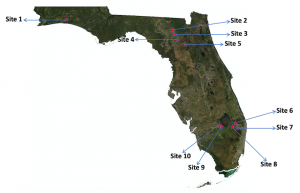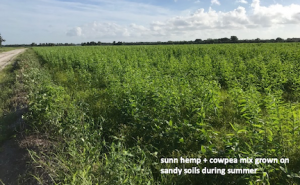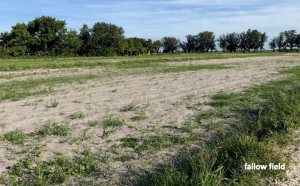Florida’s sandy soils can be a challenge for agricultural producers. Ensuring the soil retains the right amount of moisture and nutrients is a constant concern. Newly published UF/IFAS research examines how cover crops help soil health on farms in different regions of Florida.

Dr. Jehangir “Jango” Bhadha, assistant professor in the Soil and Water Sciences Department at the Everglades Research and Education Center, led the two-year study funded by USDA-SSARE. With a handful of extension agents, his research team assessed ten farms across the state that use cover crops instead of letting fields fallow between growing seasons.
“There was a lot of enthusiasm from the growers to learn how their soils behaved when they practiced cover cropping during the fallow period,” said Bhadha, “Growing cover crops is perhaps the most valuable strategy we can adopt to feed our soil, build up its fertility, and improve its structure with each passing season.”
Assessing Soil Health
“Our goal was to shadow each farm’s practice and determine the impact on soil health indicators,” Bhadha explained.
 Those indicators include soil pH, maximum water holding capacity, organic matter, soil protein, and total nitrogen, phosphorus, and potassium, among other characteristics. The types of cover crops ranged from cowpea and sunn hemp to alfalfa, oats, and rye. Conventional soil tests typically comprise of soil nutrient measurements that can help with fertilizer recommendations. However, determining soil physical and biological parameters can provide vital information about the overall soil quality.
Those indicators include soil pH, maximum water holding capacity, organic matter, soil protein, and total nitrogen, phosphorus, and potassium, among other characteristics. The types of cover crops ranged from cowpea and sunn hemp to alfalfa, oats, and rye. Conventional soil tests typically comprise of soil nutrient measurements that can help with fertilizer recommendations. However, determining soil physical and biological parameters can provide vital information about the overall soil quality.
 The results show, in general, cultivating cover crops over fallow periods could be a viable option for Florida’s growers. Cover crops showed beneficial effects on soil health over all the farms statistically. However, it remains unclear if long-term improvements in soil fertility can be achieved under Florida conditions.
The results show, in general, cultivating cover crops over fallow periods could be a viable option for Florida’s growers. Cover crops showed beneficial effects on soil health over all the farms statistically. However, it remains unclear if long-term improvements in soil fertility can be achieved under Florida conditions.
“Cover crops performance depends on many factors such as cover crop species selection, climate conditions, soil types, cropping systems, and management,” Bhadha pointed out.
He also stressed that implementing cover crops into a cropping system requires time, money, inputs, labor, machinery, and proper management. Each farm has to determine what is best for its operation.
The research is published in the journal Sustainable Agriculture Research. You can read the full article and see the results for each farm’s cover crop practice here: http://www.ccsenet.org/journal/index.php/sar/article/view/0/44663
 0
0
